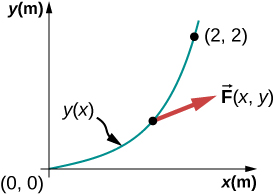| << Chapter < Page | Chapter >> Page > |
Check Your Understanding Can Earth’s gravity ever be a constant force for all paths?
No, it’s only approximately constant near Earth’s surface.
In general, forces may vary in magnitude and direction at points in space, and paths between two points may be curved. The infinitesimal work done by a variable force can be expressed in terms of the components of the force and the displacement along the path,
Here, the components of the force are functions of position along the path, and the displacements depend on the equations of the path. (Although we chose to illustrate dW in Cartesian coordinates, other coordinates are better suited to some situations.) [link] defines the total work as a line integral, or the limit of a sum of infinitesimal amounts of work. The physical concept of work is straightforward: you calculate the work for tiny displacements and add them up. Sometimes the mathematics can seem complicated, but the following example demonstrates how cleanly they can operate.

Then, the integral for the work is just a definite integral of a function of x .
The integral of is so
Check Your Understanding Find the work done by the same force in [link] over a cubic path, , between the same points and
You saw in [link] that to evaluate a line integral, you could reduce it to an integral over a single variable or parameter. Usually, there are several ways to do this, which may be more or less convenient, depending on the particular case. In [link] , we reduced the line integral to an integral over x , but we could equally well have chosen to reduce everything to a function of y . We didn’t do that because the functions in y involve the square root and fractional exponents, which may be less familiar, but for illustrative purposes, we do this now. Solving for x and dx , in terms of y , along the parabolic path, we get
The components of the force, in terms of y , are

Notification Switch
Would you like to follow the 'University physics volume 1' conversation and receive update notifications?